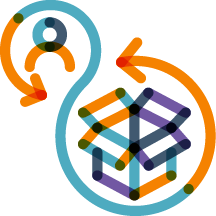Professional Scrum Competency: Managing Products with Agility
 Managing Products with Agility results in products that provide valuable business outcomes, increased flexibility to respond to change, and greater transparency for investment decisions in product development. A clear and understandable Product Vision helps to align product development with the organization’s Business Strategy including strategic goals and/or business vision, while a focus on Product Value addresses the continuous improvements to the product. Product Value includes considerations such as greater transparency in value-based decisions and organization-wide, value-driven approaches. Key tenets of this Focus Area include continuously defining value, measuring actual value realized, validating assumptions, and analyzing trends.
Managing Products with Agility results in products that provide valuable business outcomes, increased flexibility to respond to change, and greater transparency for investment decisions in product development. A clear and understandable Product Vision helps to align product development with the organization’s Business Strategy including strategic goals and/or business vision, while a focus on Product Value addresses the continuous improvements to the product. Product Value includes considerations such as greater transparency in value-based decisions and organization-wide, value-driven approaches. Key tenets of this Focus Area include continuously defining value, measuring actual value realized, validating assumptions, and analyzing trends.
The process of aligning Product Vision with Product Value is iterative and incremental, and it is managed through continuous refinement of the Product Backlog. Effective Product Backlog Management requires input and collaboration from a variety of Stakeholders and Customers - including the Scrum Team - and requires evolving techniques to ensure appropriate levels of transparency based on the needs of stakeholders. Similarly, Forecasting and Planning uses an iterative and incremental approach to manage complexity, change, and the realities of business obligations. Attention to these Focus Areas results in development and delivery of valuable product increments within 30 days or less. Additional features and benefits of these approaches include increased transparency to progress, more realistic and evolving forecasts to manage stakeholder expectations, and applying appropriate release, sales, contracting, and partnering strategies.
The Product Owner is typically focused on Managing Products with Agility, however, proficiency in this competency is required by all Scrum Team members, Agile Leaders, and organizational stakeholders to ensure that the full value of using the Scrum framework and an empirical process is achieved.
Key Focus Areas
Within each competency, a number of Focus Areas provide a more detailed view of the knowledge and skills you require to master that competency.
Forecasting and Release Planning
Complex problems and the application of an empirical process requires a specific way of planning, estimating, and forecasting. Practitioners should be able to apply agile forecasting and release planning techniques, and understand the value of different approaches. They should understand which approaches work better in different situations. They should also understand how releases should be planned while dealing with complexity, dependencies, and value creation.
Product Vision
The product vision defines the purpose that the product aspires to fulfill. It is defined by the value that the product strives to deliver. Practitioners should be able to describe what a product vision is and what techniques should be employed to both build a vision and make it transparent. They should also understand how to use a product vision to drive strategy and execution, and how to build a vision that motivates, communicates, and provides constraints for delivery.
Product Value
The ultimate goal is to deliver value to the customer and stakeholders. But value is complex, made up of long-term and short-term impact, internal and external value, and indirect and direct value. The practitioner should be able to understand how to define value for context, and apply it to the work they and the team do. They should be able to manage others' understanding of value and apply different techniques and practices for defining, communicating and measuring value. They should understand the connection between value and empirical process, and how value should be the driving factor of the Product Goal.
Product Backlog Management
The Product Backlog is a key artifact within Scrum. It is an ordered list that describes what is needed in the product. The Product Backlog provides transparency into what is happening to the product for the team, organization, and stakeholders. The practitioner should be able to describe what a Product Backlog is and apply a variety of techniques for managing the backlog. They should also understand how to make the Product Backlog transparent and how to manage stakeholder expectations associated with the backlog.
Business Strategy
A product lives within the context of a business strategy. That strategy describes how the Product Vision will be executed in a broader context. A practitioner will understand techniques for exposing business strategy and show how it drives the product. They will understand approaches, such as Lean Startup and Design Thinking, and how those affect the flow of ideas from strategy to execution. They will understand how an empirical process affects the execution and feedback of a strategy.
Stakeholders and Customers
Effectively working with stakeholders and customers is a key skill for everyone on the Scrum Team. Scrum changes the nature of the interactions, encouraging more frequent collaboration and more open dialogue. The practitioner will understand the implication moving to an Agile approach will have to their stakeholders and customers and also become familiar with practices and stances that will help them work and collaborate in a more agile way.